How to Create the Ultimate ROI-Boosting SaaS Content Strategy

A SaaS content strategy can feel overwhelming. That’s because every company in the industry faces fierce competition. Plus, SaaS companies typically need to work with more than a buyer persona.
It’s challenging, but definitely not impossible. And we’re here to help.
This mega-guide will teach you how to create a SaaS content strategy, step-by-step, with detailed instructions and examples.
This is what we’re going to cover:
- What Is a SaaS Content Strategy, Anyway?
- Why Do You Need a Content Strategy for Your SaaS Business?
- Hands-On: How to Create a Winning SaaS Content Strategy
- Who Are Your Writing for?
- How to Match Your SaaS Content Marketing to the Buyer’s Journey
- SaaS Content Writing 101: Finding Your Brand’s Tone of Voice
- Types and Formats of Content for SaaS Companies
- Content Marketing for SaaS: How to Distribute and Promote Your Content
- How a SaaS Content Writing Team Can Help You with Strategy?
Ready?
Let’s dig right in!
-
What Is a SaaS Content Strategy, Anyway?
A SaaS content strategy is a roadmap that helps you tie your business goals to your content planning, executing and promoting. It’s more than an editorial calendar (although that’s a part of it). A strategy has clearly defined goals, KPIs and evaluation methods.
Here’s the brutal truth: content writing isn’t easy. It takes time, effort and a lot of knowledge.
BUT when done right, it can yield results for years to come. The case study below proves it:
Learn how a Copywritech client in iPaaS generates 50% more leads and converts 25% more customers through content planned and executed by us.
However, for SaaS content marketing to work, it needs a coherent strategy. There is no one-size-fits-all when it comes to strategies, so you will have to fill in the blanks with your own answers.
These are the first questions to ask yourself when building a SaaS content strategy:
- What are my content marketing goals? –> Choose measurable goals, like free trial signups, traffic, lead generation or lead conversions.
- How do my content goals align with my business goals? –> If you can’t map your content efforts to your business goals, discard any tactic that comes to mind.
- Who are we writing for? –> Who is your buyer persona (ideal client)? More on that below.
- What topics will we write about? –> How will they help our buyer persona? If you can’t connect certain topics on your editorial calendar to the needs of the buyer persona, discard them.
- How will we get our content under the right eyes? –> How will you promote and distribute your content. Map out all channels in advance.
These are the basics or the bare bones of your content strategy. If you have all the answers to the questions above, you can start planning.
If not, go back to the drawing board and take a closer look at your buyer persona. This is where your inspiration should come from.
How does all this Q&A help with your SaaS content strategy?
In case it’s not yet crystal clear, we delve into that below.
-
Why Do You Need a Content Strategy for Your SaaS Business?
Gartner predicts (again!) a huge growth of the XaaS market.
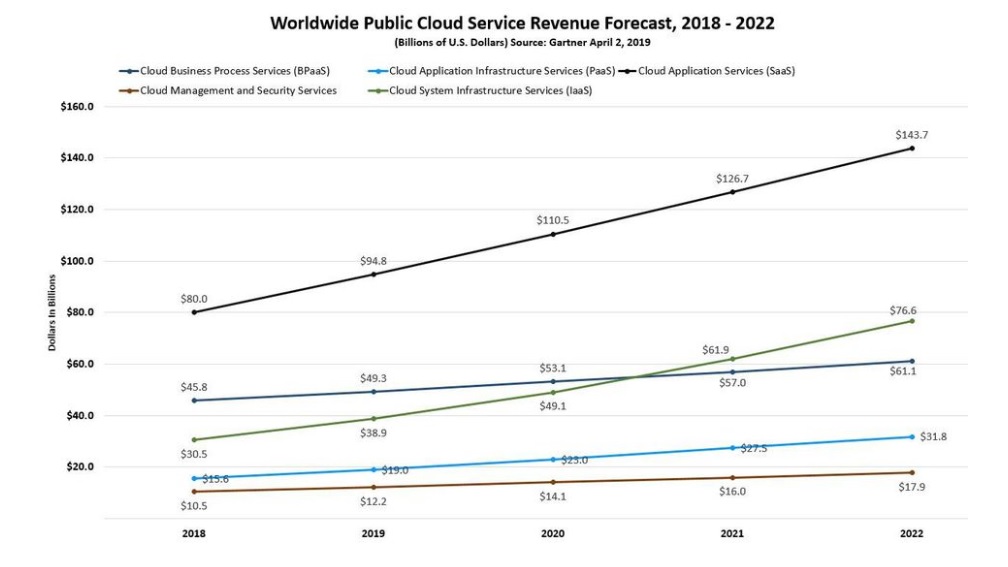
Image via Forbes
Year after year, it seems that the revenue of XaaS companies increases consistently. SaaS makes no exception here, with the Software-as-a-Service market estimated to reach $143.7 billion by 2022. It is the biggest growth and revenue projection of all the XaaS sub-industries.
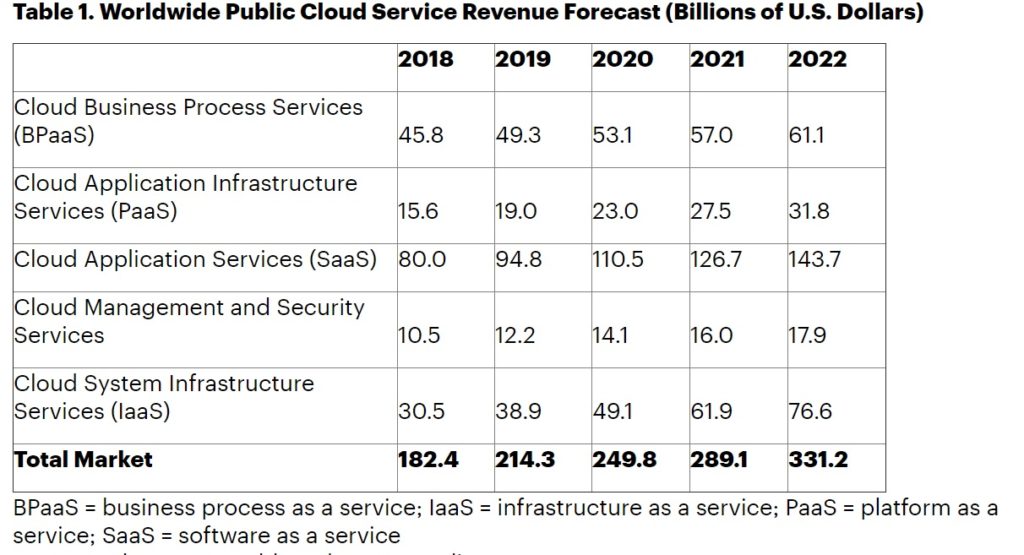
Image via Gartner
These are, of course, great news for SaaS companies.
But, as always, there’s a catch.
More and more SaaS companies appear every day, hoping for a big chunk of those billions.
Even more, a huge percentage of that revenue is eaten up by the REALLY big guns like Microsoft and Salesforce:

Image via FinancesOnline
This spells trouble in the form of increased competition in the SaaS industry. A SaaS company founded in 2012 had an average of 2.6 competitors in its first year of business. Only five years later, the number of competitors increased to 9.7.
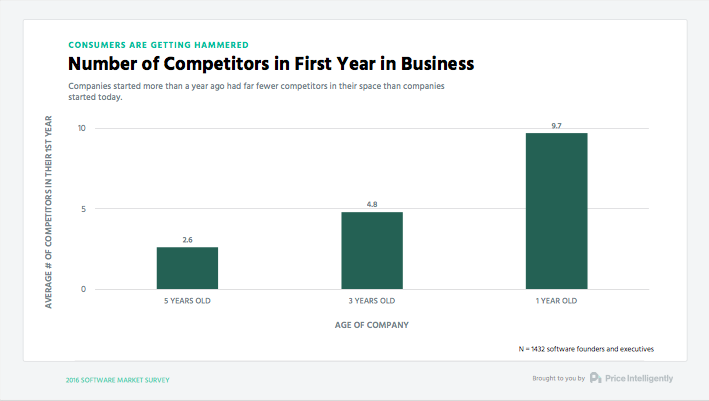
Image via Price Intelligently
This is one of the key areas where a great SaaS content strategy can truly make a difference. Yes, you face fierce competition.
Yes, in all likelihood, things won’t be better next year.
But you can use content to differentiate yourself from your competitors.
In this case, the statistics are on your side: companies who have a content marketing strategy in place get a 30% higher growth rate than those that don’t.
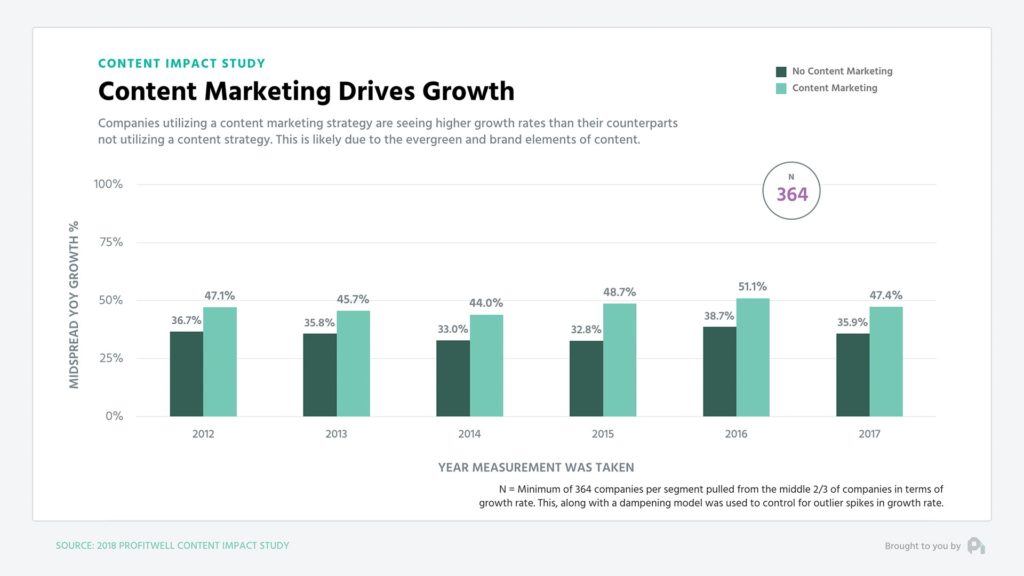
Image via Profit Well
Furthermore, 47% of buyers engage with three to five pieces of content before even speaking to a sales rep. Conversion and closing rates are 8 to 10 (!) times higher than those of outbound tactics like PPC ads.
Customer retention is also better with a proper SaaS content strategy in place – companies that deploy strategic content (the customer-centric kind) see 5 to 10% better retention rates.
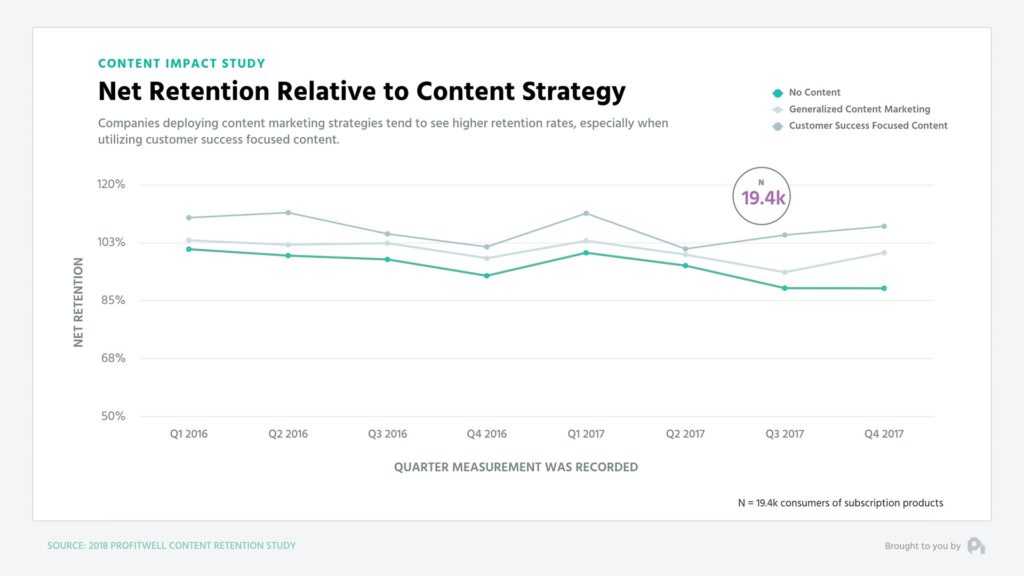
Image via Profit Well
Aside from these compelling statistics, content strategy comes with other benefits too. It helps you focus your content efforts where they matter most and where they can bring actual results and ROI.
Otherwise, why even bother publishing the odd blog post?
You will be publishing content in a vacuum, going at it blindly. How will you know if it yielded results? More importantly, you won’t even know what results to expect.
Is one conversion enough ROI for a whitepaper? Is a 20% increase in traffic enough for a year of consistent blogging?
You can’t really tell without proper KPIs in place. The research entailed by your content strategy can (and should!) reveal the right and the realistic marketing and business results you can expect from every single one of your content pieces.
Need help with your content strategy? We’re here for you! Whether you need a simple chat with a SaaS growth specialist or a full, detailed content or marketing strategy roadmap, we’ve got you covered. Check out our services and let’s talk!
3. Hands-On: How to Create a Winning SaaS Content Strategy
Sadly, it’s not enough just to know that some stats are on your side. You also have to make a real plan for how to leverage them aka how to do SaaS content marketing the right way. After all, “a goal without a plan is just a wish” (Antoine de Saint-Exupéry), right?
So, now that you know why SaaS content marketing can be a game-changer, let’s get down to the nitty-gritty of it all.

GIF via GIPHY
a. Who Are You Writing for?
The best SaaS marketing campaigns always start with the buyer persona. If you’re stumped for ideas, always go back to them.
Take a closer look at the profile of your ideal customer and you’ll know what to write, when to publish and how to promote your content.
But in order to do that, you have to know your buyer persona really well. And I don’t just mean the usual
“Our SaaS is ideal for small businesses with 5 to 10 employees.”
This is wrong on so many levels!
First off, you can’t create content for a business. A business can’t read or watch videos. A business is a fictitious construct.
There are actual human beings behind every business. They are the ones you are creating content for.
Next, your SaaS can’t be a great fit for every business in every field.
For example, a social media management tool like Buffer or Sendible can say that they serve companies in every industry. After all, everyone’s on social media these days, right?
BUT this doesn’t mean that every company in every industry is their ideal client. If you look closely to their content strategy, you’ll see that they (mostly) target:
- Digital marketing agencies (industry segmentation)
- Digital marketers freelancing, working for agencies or working companies in other fields (human-level segmentation)
Why?
It’s all about ROI – as it should be!
Digital marketing agencies are more likely to pay for a more expensive plan as they manage more accounts. The same goes for freelance digital marketers. Better yet, these two categories are their ideal buyers in more ways than one: they don’t need to be told why they need a social media management tool.
They already know that.
What they need is to compare these tools and make the best choice for their needs.
For the SaaS companies selling these tools this means:
- A shorter sales funnel + shorter buying journey
- Less money and time invested in content (they can skip the learning phase)
I know, it sounds easy when you look at what others have already done. But you can’t have a SaaS content strategy without a properly defined buyer persona.
Let’s see how you can do this for your own business from scratch.
How to Create a Buyer Persona in Four Easy Steps
Step 1: Research your audience
Start by looking at your existing clients:
- Who are they? (Name, company, job title, location, socio-demographic traits)
- Why do they keep buying from you?
- What type of content do they consume regularly or consumed before becoming your customers? (Think about your own content here)
- What other content platforms do they engage with regularly?
Ideally, you should also interview these people to learn more about their pains, their needs and their preferences.
Of course, your main focus should be on their motivation – what made them choose your services. Try to narrow it down to the type of content they consumed in every stage of their buyer journey if possible.
However, there are other seemingly unrelated questions that you can ask and that will help you with your content strategy for SaaS. Here are some examples of things you need to ask directly (because the chances of finding the answers in analytics reports are slim to none):
- What other tools (SaaS or not) do you use at work?
- How is the success of your role measured?
- What are your biggest challenges?
- What is your educational background?
- If possible/appropriate, try to get more socio-demographic details directly from them: age, location, are they married or not, do they have kids?
- How do you find new information that helps you get better at your job? What media outlets do you follow?
- How do you do internet research? Where do you start? Is it with a broad Google search or something else?
- What’s your preferred channel for interacting with a vendor (email, phone, social media)?
By now you should have enough information to move on to step 2.
Step 2: Narrow down the common traits, features and needs
When you find some commonalities between your most valued customers, you’re on the right track to creating your buyer persona aka the core of your SaaS content strategy.
Try to draw parallels between the answers you got. For instance, do the people who have kids share an interest in a certain media outlet? This could help you with your guest posting strategy.
Are people who manage teams more likely to prefer vendor engagement via email while those without management roles prefer phone calls?
Pay extra attention to the challenges they list (this can give you tons of ideas for new content), as well as to how the success of their role is measured (for the same reason).
Step 3: Give them a name
This may sound silly, but it’s actually quite an important step in your content strategy. When you give your buyer persona a name, you instantly humanize them.
You know that you don’t write for a faceless, nameless mass of people. You can even attach a photo to your buyer persona.
Quirky names like ‘Marketing Sally’, ‘Landscaper Joe’ or ‘DevOps Dana’ are quite common.
Go nuts here – it’s the ideal place to show off your creativity.
Step 4: Rinse and repeat for your other buyer personas
It’s quite likely that you will be working with more than one buyer persona. Repeat the process in steps 1-3 for each of your personas.
A word of caution, though: make sure you don’t overdo it. It can be tempting to create more personas than you need either by differentiating using too many criteria or by creating categories that are too small to matter in your content strategy.
The cases where you’d need more than five buyer personas are rare. If your initial research reveals more than five, try to go over your criteria again and see if the differences between your personas are significant enough to warrant splitting them up.
This is a great buyer persona example by BuyerPersona.com.
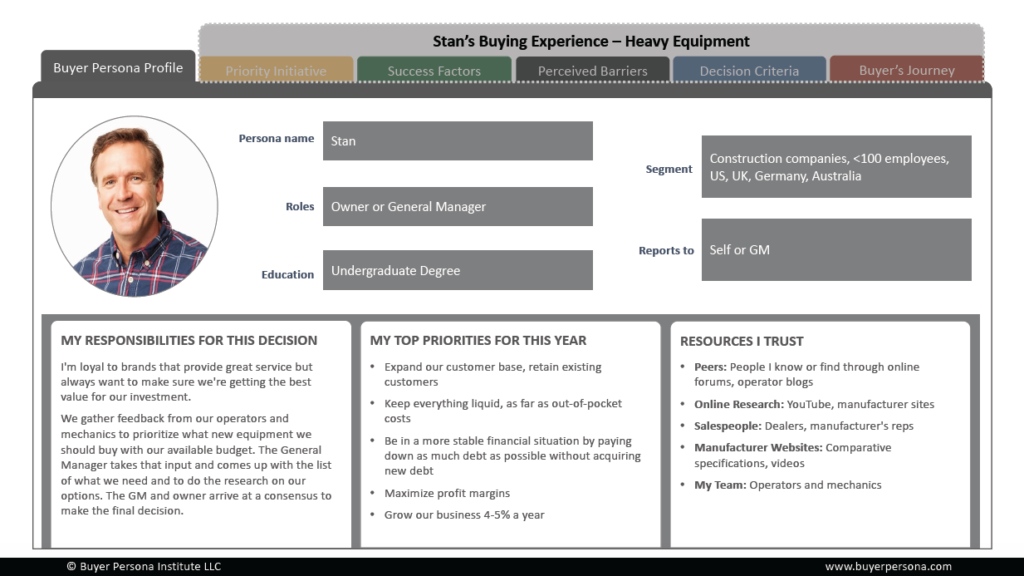
You can start creating your own persona using this fun tool by HubSpot.
b. How to Match Your SaaS Content Marketing to the Buyer’s Journey
This is, perhaps, the most important part of your SaaS content strategy. Acknowledging that different people have different needs – when it comes to both SaaS content and SaaS products – was already covered in the chapter above.
Now it’s time to acknowledge that even the same buyer has different needs at different points in time.
This is where mapping the buying journey comes into play.
The principle is quite simple: you need to create different content based on where in that journey your buyer is. For example, you wouldn’t hit a prospect that doesn’t yet know how your SaaS could help them out with an infographic that compares your tool with your competitors’, would you?
Let’s see how this journey looks like for a SaaS buyer:
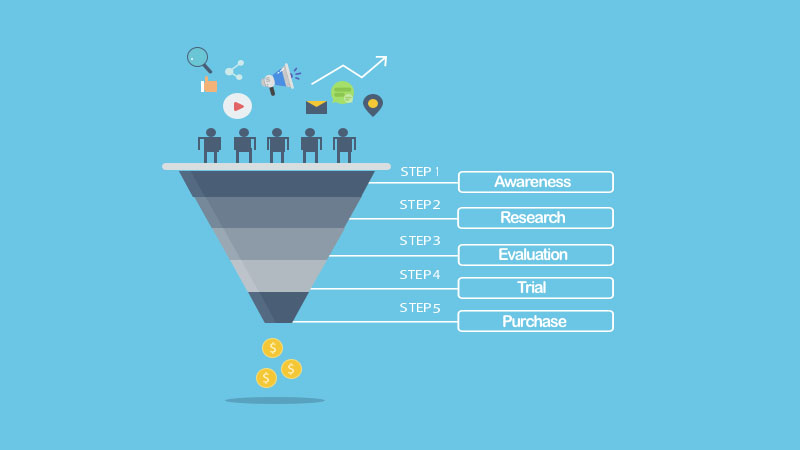
Image via Pathways Digital
You’ve got the five main stages of the buying journey above. To them, I would add two more: re-purchase (or upsell) and advocacy.
These two stages are extremely important because they can boost your ROI significantly. We already know that it costs $1.32 to acquire an annual recurring revenue of $1 from a new customer. On the other hand, it only costs $0.71 to acquire the same dollar from an existing customer.
This is why it’s never healthy to only focus on acquiring new clients. You’re basically leaving money on the table if you don’t include re-purchase/upsell or advocacy in your SaaS content strategy.
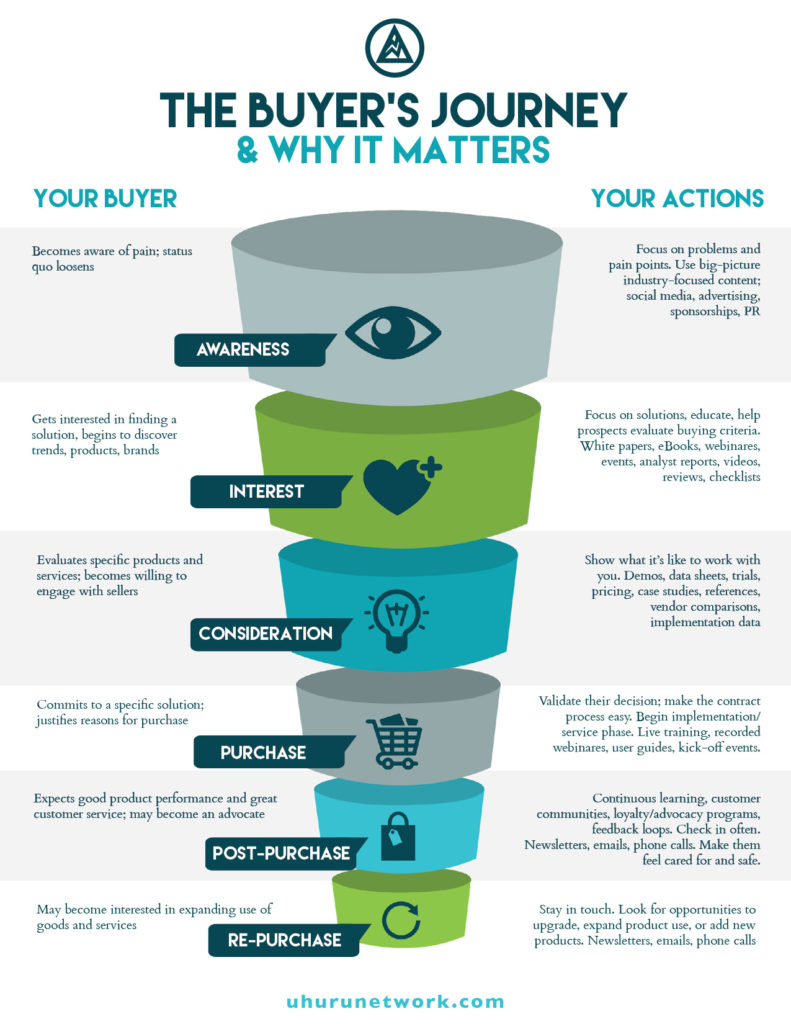
Image via Uhuru Network
So, how do you put all this into action?
You start mapping the buyer journey for ALL your buyer personas.
Why can’t you have a single buyer journey for everyone, you ask?
Because different personas buy in a different manner. And your SaaS content strategy needs to reflect this.
Remember that, if you want your content to bring actual ROI, you have to get hyper-targeted and offer hyper-personalized content to each of your personas. And this isn’t just about email marketing.
It’s about every single type of copy or content.
Even more, not all your personas may go through all the buying stages.
Remember the Buffer example above?
A digital marketing agency decision-maker already knows that they need a social media management tool. So they don’t need content that teaches them its benefits. They don’t need to be made aware that you can solve their problems.
What they need is content that shows them why your SaaS social media solution is better than your competitors’.
Let’s take an in-depth look at the ideal content tactics and formats for each stage of the buying journey.
Awareness Stage Content
Your buyer persona doesn’t know you yet. You already know something about them but this phase is excellent for you to refine your buyer persona traits. You can use:
- SEO content — aim for long-tail, educational keywords like: ‘how do I schedule social media posts in advance’.
- Blog posts – go long-form on topics that truly help your audience. Keep advertorial content in blog posts to a minimum (one CTA is enough)
- PPC advertising – like Google Ads or Facebook Ads. Invest in promoting the content we discussed above instead of your free trial or your pricing page. Remember that you’re still at the top of the funnel.
Interest Stage Content
Your buyer persona knows there is a solution to their pain points. If you did your job right in the first phase, they may already know your brand. They are now carefully considering a provider. Make sure that provider is you through:
- SEO content – this time go for keywords like ‘how to choose the ideal social media management tool’.
- Blog posts — again, resist the urge to make this too promotional. For instance, a blog post with this title should list an objective list of features a prospective buyer should be aware of and then invite them to a/your free trial to see those traits in action.
- Videos and checklists – also geared to educating users on how to make their own choice
Consideration Stage Content
This is where the funnel really starts to get narrower and where you can really start to evaluate the success of your SaaS content strategy.
The user is ready to make a choice. You are on their shortlist.
How do you ensure you are their final choice?
- Whitepapers – prove your in-depth knowledge of your industry and their pain points through state-of-the-art content that offers unique solutions to their problems.
- Case studies – let your existing customers be your advocates. Show how you’ve helped others. Make sure that your case studies are focused on the RESULTS your clients got. It may sound silly, but USE NUMBERS to show your clients’ growth and results. Like we do with our case studies.
- (Free) trial – this is the time to push your trial. Promote it in PPC ads, blog posts, media buying, affiliates and more.
- Vendor comparison sheets – show why your SaaS is a better choice for that particular client. If you think a comparison sheet for each buyer persona is doable, go for it. Again, the more personalization the better!
- Demo videos and written content – show your solution in action with relevant use cases. Make sure that every piece of content here is created to depict real-life uses of your solution.
Purchase Stage Content
Congratulations! Your SaaS content rocks and you’ve got a new purchase. But your job here isn’t done.
You have to reassure your brand-new customer that they did a great job with:
- A personalized email sequence — start by thanking them for their purchase. Then move on to making the rest of their journey as easy as possible. Set-up help and instant start of service delivery are crucial here.
- Blog posts – announce every new feature of your solution. Write about different use cases and scenarios. Briefly put: show people how they can make the most out of your solution.
- Live training sessions and recorded webinars – some people prefer video how-tos. Make sure they can find all your kick off guides in as many formats as needed
Re-Purchase/Upsell Stage Content
Remember how we discussed it’s cheaper to upsell an existing customer than to chase a new one? Make sure you reduce your churn rate and increase ROI per client by creating relevant content for existing customers:
- Personalized emails — ensure that your customers are the first to learn about new features, updates and important milestones in your company.
- Offer them access to loyalty programs.
- Members-only webinars – create live or recorded webinars that only your existing customers have access to.
- Members-only content library – in-depth whitepapers and e-books that only they can access is another great way to make your customers feel like VIPs.
Advocacy Stage Content
The best advertising you can have is the one done by your clients on your behalf. 92% of customers trust peer recommendations, so you have no reason not to engage your customers:
- Case studies – offer incentives for clients who are willing to create a case study with you. A discount or even the promise of grandfathering them forever are the usual choices here. Don’t forget to mention you will include a link to their website too!
- Reviews and testimonials – remind your clients that they can leave reviews of your solution on your social media profiles or on third-party websites like G2. Ask for testimonials that you can publish on your website.
- Referral bonuses – what can you offer your existing clients if they bring in new clients? Can you make it worth their while?
OK, you know what to write and for whom to write. Let’s see HOW to write.
c. SaaS Content Writing 101: Finding Your Brand’s Tone of Voice
Your SaaS content strategy is almost done! But don’t forget about one crucial aspect that most companies leave out of their strategies: finding your unique brand voice.
Why do you need it?
Because your brand voice is part of your overall branding. You wouldn’t skip on creating a logo, would you?
The same goes for your tone of voice. Your content should be as easy to recognize as your logo.
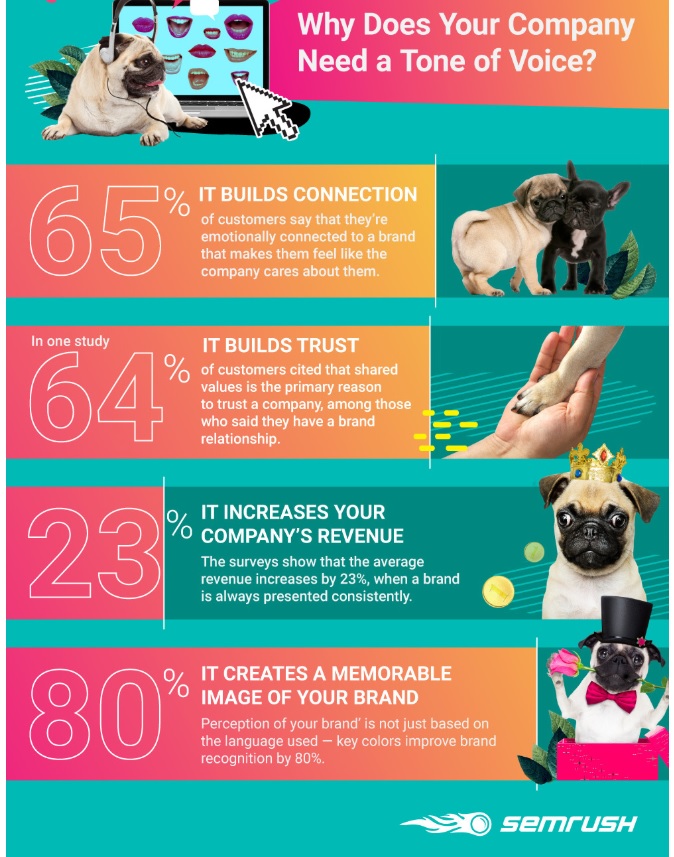
Image via SEMrush
In other words: if someone reads a blog post without looking at the URL, they should say ‘hey, this sounds like [Your SaaS].’
Whether you outsource content writing or you do it in-house, there are a few guidelines you have to establish before publishing a single piece of content.
As always, go back to your buyer persona. Take a look at your initial research to find out how they like to be spoken to. Analyze some of their favorite brands and learn what tone of voice they use.
Is it friendly? Quirky? Authoritative? Confident? All-business? Funny?
There is no one-size-fits-all here.
But you can find your unique tone of voice:
Step 1: Analyze your existing content
Look at your website, blog posts, even social media posts.
Which of them could have been written by anyone? Discard them.
Which of them stand out from the crowd? Focus on those.
They most likely reflect your current brand voice. But this doesn’t mean it’s your ideal brand voice.
Next up in your initial analysis: take a look at your top-performing content. Can you identify any tone of voice commonalities between those pieces of content?
If so, you’re on the right track.
If not, don’t despair. You’ll learn more about identifying your brand tone of voice below.
Step 2: Humanize your content
If your brand’s content were a human, what would they be like?
You know that annoying interview question – “how would your friends define you?” Ask the same question, but change “friends” to “audience”.
How would your audience define your content? Is it helpful or promotional? Funny or straightforward? All-business or quirky?
How would your audience like your content to be?
Any overlaps between the answers to those two questions? Those are the adjectives you need to focus on.
Step 3: Create a tone of voice chart
This little chart will be a crucial document for your SaaS content strategy. You can revisit it anytime to make changes as your company evolves and so do the needs of your audience.
Start with the adjectives you inventoried in the step above. Then associate them with your brand’s traits and translate them into actionable tips.
This chart by Erika Heald is an excellent example:
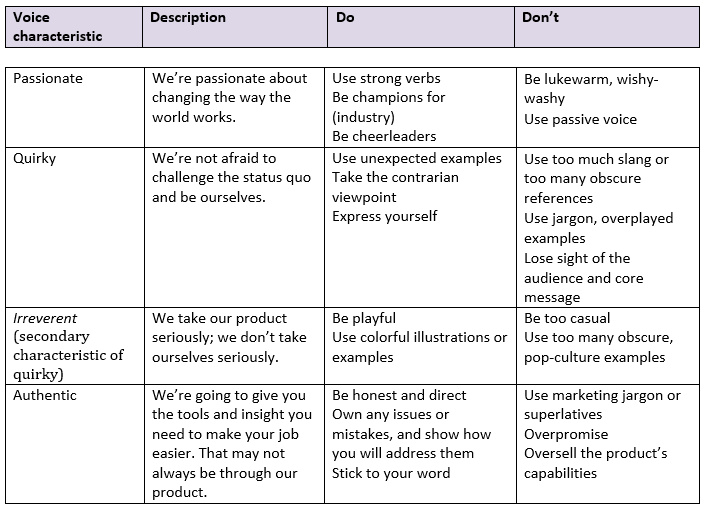
Image via Content Marketing Institute
d. Types and Formats of Content for SaaS Companies
One of the biggest marketing challenges for SaaS companies is setting limits. Limits to the number of social networks they’re on, limits to how much content they create, and, of course, limits to the types of formats of content they create.
In a world where FOMO rules, it becomes increasingly hard to let go of some marketing tactics so you can focus on others better.
That’s perfectly understandable.
But here’s the thing: you can’t be everywhere and create every type of content known to marketers. Or, at least, you can’t do it right.
You don’t want to spread yourself thin and create average content for your SaaS and then find that you don’t even have the resources to promote everything you’ve created.
Focus on the content types and formats that you have the time and the resources to create AND do an excellent job while at it.
And, more importantly, focus on the types and formats of content that your audience wants to consume. Discard the rest without a second thought.
Why would you invest time and money in content that you can’t do properly and that no one really needs?
The list below is an overview of content types and formats for SaaS companies. Feel free to experiment with a few of them so you know what to focus your efforts on.
But don’t set out to create every possible type of content, OK?
- Blog posts
- Long-form how-to guides
- Paid articles
- Guest posts
- Podcasts
- Whitepapers
- E-books
- Video tutorials
- Webinars
- Case studies
- Testimonials
- Social media posts
- Social media ads
- Infographics
- E-courses
- Newsletters
- Email sequences
- Photos
- Presentations (slides)
- Special promotions
- Interviews
- Q&A sessions
- FAQ section
- Product announcements
- Company news and updates
- SaaS solutions comparisons
- Contests and raffles
- Forum posting
- Press releases
- Website calculators
- Microsites
- Technical documentation
- API notes
- Datasheets
- Wikis
- In-app messages
- Original research reports
This list is by no means exhaustive.
Plus, almost every item on this list can be created in multiple formats.
Feel free to mix and match every way you see fit.
If you plan to test which of the types and formats of SaaS content work best for you, remember that you don’t need a new topic for each test.
For instance, a long-form blog post can be repurposed into a webinar. Similarly, a webinar can be repurposed in a series of blog posts. Your original research reports can generate amazing press releases or white papers.
And so on.
Repurposing content is an excellent way to make the most out of every great topic idea you have. Plus, you can reach more people just by switching formats.
For more ideas on this, check out this extensive post on how to repurpose your content.
e. Content Marketing for SaaS: How to Distribute and Promote Your Content
You’ve created the perfect blog post. You know it will help your ideal customer and that it might even convert one or two people.
So you hit publish and wait.
Is that enough?
Does great SaaS content get discovered just because you published it?

GIF via GIPHY
Even the best content needs help along its journey. You need to help its ideal reader discover it.
Some SaaS content promotion tactics are:
- SEO
Ideal for every stage of the funnel, SEO lets you get discovered by people who are looking for the answers and the solutions you’ve already written about.
Pro tip: go for long-tail keywords for your top-of-the-funnel content (like ‘how to do X quicker’).
For bottom-of-the-funnel readers, remember to always optimize your case studies and your comparisons with similar tools.
While SEO is definitely more popular for the first leg of the SaaS journey, if done right it can guide visitors to your website from the top to the bottom of the funnel.
The best part about SEO content is that it can yield results for years to come. Unlike PPC ads, a well-written blog post can bring in visitors long after it was published and you stop investing in promoting it.
Looking for SEO content that converts AND ranks? Check out our pricing page and let’s talk about making your SaaS the star of SERPs.
- Social Media Posting
Written a new blog post of a new case study? Publish it on all your social media channels.
There are plugins that can help you do this automatically, but I always recommend spending a bit more time on promoting your content.
Don’t simply publish the link and forget about it!
Instead, make sure you write enticing captions so people click on it. Briefly explain what benefits they can get if they read your content. For instance – ‘Learn how to create a winning SaaS content strategy from my guide. Examples and how tos included’ would be a great caption to promote this very article.
Furthermore, don’t promote a piece of content just once. Use a social media management tool to schedule it for weekly or monthly publishing. If you can mix and match your publishing hours, it’s even better.
Why?
Social media networks have a notoriously low organic reach. A single post will not reach all your fans or followers. But the more you publish it, the better your chances of reaching a bigger chunk of your audience.
A piece of evergreen content (like this one) can be re-published even for more than a year – especially if you refresh it every once in a while to add new stats and delete obsolete data.
Finally, for an extra bang on social media, make sure to tag the outlets or influencers you mention in your content. They will be more than pleased to see you’ve linked to them and they will definitely share/retweet your content.
- PPC Ads
As mentioned above, the organic reach of social media business profiles has decreased continuously in recent years. Just take a look at the stats for Facebook:
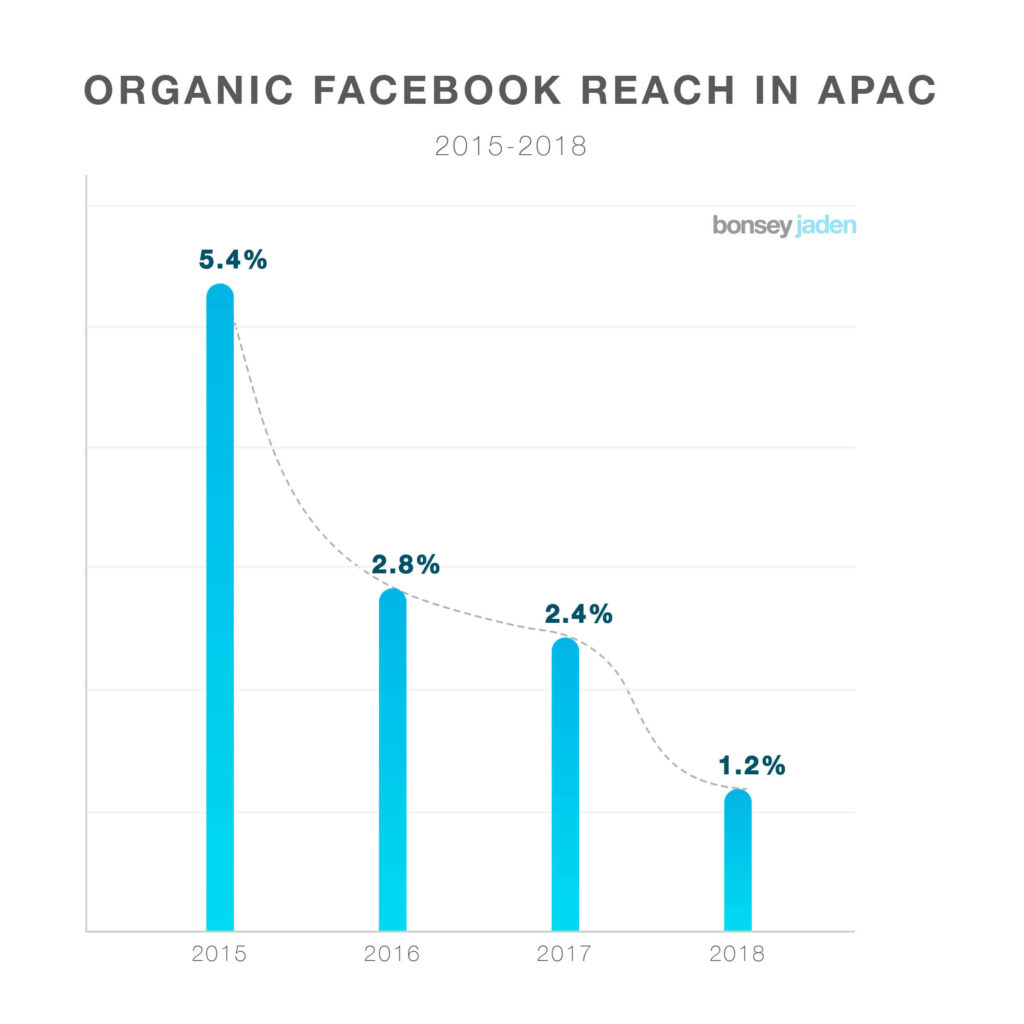
Image via Falcon
My advice is to invest even a smidge of budget to give your newly-published content a boost. It really doesn’t have to be a fortune.
Sometimes even $5 to $10 per new blog post is enough to get the ball rolling.
You see, in social media networks popularity breeds popularity. The more engagement a post gets in its first hours, the more its organic reach will grow, too.
That’s because the algorithms see that your post sparked interest and it assumes others will want to see it, too. A small advertising budget ensures that your post doesn’t get buried in your audience’s feeds.
- Email Broadcast
Published something new on your blog? Or a new case study or research report?
Make sure your email subscribers are the first to learn about it. You want to treat them like VIPs, right? That means offering them some unique benefits – like ensuring they get a first-row seat to all the goodies in your SaaS content plan.
Pro tip: try to segment your list properly. This may mean that some pieces of content only reach 10% of subscribers.
That’s OK.
What’s more important is that they reach the right people.
You don’t want to flood your subscribers with content they don’t care about. You want them to have access to truly helpful pieces of content that might push them forward on their buying journey.
- Guest Posting
In other words: write for others. These are unpaid gigs – you don’t get any money for the content you produce for third-party websites.
But what you get in exchange could be even more valuable.
Backlinks! That’s the Holy Grail of SEO!
Plus, if you published a truly amazing piece of content, like a whitepaper or an original research report you can even add a CTA for people to click on your link in the guest post.
How do you find websites you can pitch new topics to?
As usual, go back to your buyer persona analysis. Take a look at the media outlets they love to read. This should be your starting point.
Got only two or three BIG names in there? Don’t despair!
Sure, those big names may not accept your guest posting pitch. But those names are a starting point for you.
Use them to find similar outlets that are looking for guest contributors.
Pro tip: always check submission guidelines. Make sure that the post you submit abides by them. The most frequent rule is no overt promotion – never break that rule!
This is the bare minimum you can do to get your content noticed. Most of these tactics are free, but depending on your budget you can add some more paid ones.
However, the most important thing to keep in mind here is that you should never publish and forget. Crossing your fingers doesn’t work. No SaaS content strategy is complete without a promotion plan.
(More on how to promote your content in an upcoming post. Stay tuned!)
4. How a SaaS Content Writing Team Can Help You With Strategy
After working with dozens of XaaS companies, I have found that having a SaaS content strategy and implementing it right are two different things.
Oftentimes, SaaS founders or marketers are too busy to write the content they want to publish or even to create the editorial calendar.
They know what they want to write about –by and large –, but defining the actual topics and researching keywords take a lot of time.
Even though we started out as SaaS content creators, we realized that our clients need more than ready-to-publish content. They need help with their entire (or parts of their) SaaS content strategy.
This is why we have created dedicated services to support XaaS companies with all their needs. I wholeheartedly believe that content works. And I have the numbers to prove it – not just in our case studies, but in our own growth too. Copywritech is my second agency and, much like Idunn, its growth is 99% content-based.
But content only works if done right and done timely.
In order to help out with some of the biggest marketing challenges for SaaS companies, we have create separate services like:
- SaaS marketing strategy – a complete marketing roadmap for new and established companies alike. It includes more than content strategy and it’s a standalone document to be used in-house or shared with outsourcing partners.
- Editorial calendar – a done-for-you spreadsheet with topics to tackle, SEO/keyword research and suggested outlines and promotional tactics.
- One-off consulting call with me – ideal for when you need a bit of help with tweaking your SaaS content strategy. You get to pick my brain for an hour and find out how we helped XaaS companies get up to 50% more leads through content alone.
- Content writing – ready to publish, SEO-friendly and conversion-friendly content.
Copywritech can help you with your entire strategy or parts of it – depending on your needs and your own team’s availability.
Want to know more about how we can make your SaaS content strategy rock? Fill in the form below and tell us a bit about your business. We’ll take it from there.
7 Comentarii la “How to Create the Ultimate ROI-Boosting SaaS Content Strategy”
[…] blogging works for tech companies – I’ve been there for the whole process, from mapping the SaaS content strategy to evaluating its […]
[…] blogging works for tech companies – I’ve been there for the whole process, from mapping the SaaS content strategy to evaluating its […]
[…] make a killing by publishing the odd 500-word blog post now and again. You need a consistent content strategy and a consistent publishing […]
[…] put, there are two things you should be considering for your KPIs (and for your content strategy in general): your users and your business goals. When you mind them both, you will see growth. If […]
[…] a more detailed approach to creating a content strategy? My guide on SaaS content strategy is very comprehensive and it can easily be adapted to match other industries as […]
[…] Balancing these two figures is the key to building a sustainable and profitable SaaS content strategy. […]
[…] Buffer lesson: don’t rely entirely on your own audience if that audience is still small. The best SaaS startup content strategy is to expand your reach by guest posting or partnering with other […]